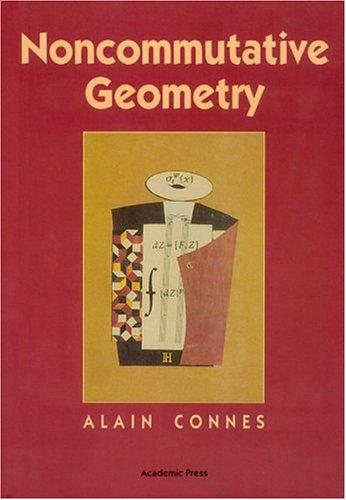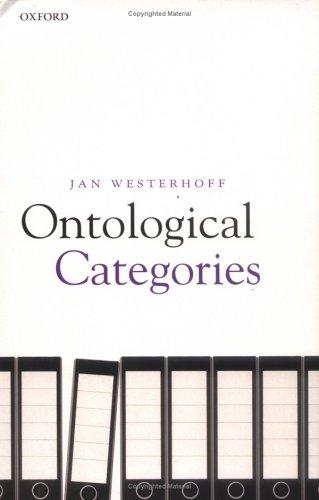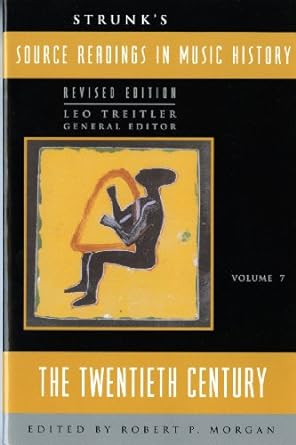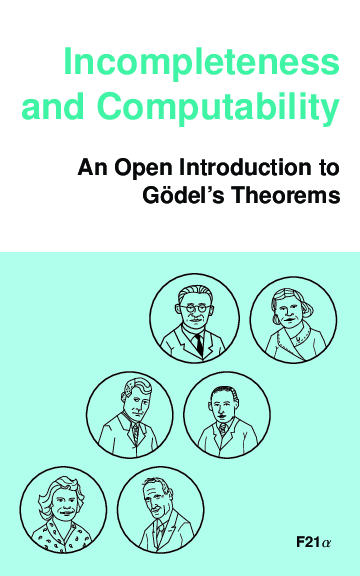gesang started reading Noncommutative geometry by Alain Connes

Noncommutative geometry by Alain Connes
This English version of the path-breaking French book on this subject gives the definitive treatment of the revolutionary approach to …
This link opens in a pop-up window

This English version of the path-breaking French book on this subject gives the definitive treatment of the revolutionary approach to …

The concept of an ontological category is central to metaphysics. Metaphysicians argue about which category an object should be assigned …

Twentieth-century music has been described as complex, vital, diverse, uncertain, experimental, self-conscious, innovative-the list is long and growing. Composers have …

Twentieth-century music has been described as complex, vital, diverse, uncertain, experimental, self-conscious, innovative-the list is long and growing. Composers have …

Textbook on Gödel’s incompleteness theorems and computability theory, developed for Calgary’s Logic III course, based on the Open Logic Project. …
The version I read is $F21\alpha$. I skipped the second-order logic chapter.
It has been years since Open Logic Project started their textbook project, but the text is still cluttered. Early on, on page 10, there's a mysterious $s$ appearing without any explanation, which, though, can only be thought of as a function that maps a variable, there $x$, to an element of the model, is still frustrating to read. Also maybe because the text if designed for philosophy students, the notion of /computable function/ is distinguished from /partial recursive function/ here, and that introduces unnecessary confusions. I prefer Cutland's approach, which is really clear.
The exposition of Goedel's theorem is mediocore. It's a text for philosophy students, not for real logicians, so no introduction of $\Sigma^0_1$-sentences, etc., which are the more important concepts if one really wants to see what's going on: $\Sigma^0_1$- and $\Pi^0_1$-formulas do not match, co-r.e. …
The version I read is $F21\alpha$. I skipped the second-order logic chapter.
It has been years since Open Logic Project started their textbook project, but the text is still cluttered. Early on, on page 10, there's a mysterious $s$ appearing without any explanation, which, though, can only be thought of as a function that maps a variable, there $x$, to an element of the model, is still frustrating to read. Also maybe because the text if designed for philosophy students, the notion of /computable function/ is distinguished from /partial recursive function/ here, and that introduces unnecessary confusions. I prefer Cutland's approach, which is really clear.
The exposition of Goedel's theorem is mediocore. It's a text for philosophy students, not for real logicians, so no introduction of $\Sigma^0_1$-sentences, etc., which are the more important concepts if one really wants to see what's going on: $\Sigma^0_1$- and $\Pi^0_1$-formulas do not match, co-r.e. sets are not r.e if they're not $\Delta_1$. It's THAT simple. The intuition behind sencond incompleteness is also simple: consistency should be characterized by $\Pi^0_1$-formulas, existential quantifier has nothing to do with consistency, hence they're not $\Delta_1$.
After all Goedel's theorem, in its traditional form, is a very /boring/ theorem to go through. Most of the energies are spent in coding symbols and terms and functions, and representing partial recursive functions in $\mathsf{Q}$. The main argument is the fixed-point argument which is, though buried by technical details, is fairly easy to grasp, while, similar to Yoneda's lemma, becomes confusing when really working with (in particular when it comes to Lob's theorem). Cutland in his chapter 8 proves the first incompleteness beautifully, in contrast, with the help of creative and productive sets, which is far more illuminating than the original proof. And Cutland's book doesn't abuse the word "true" like philosophers do, by the way, which is still present in the Open Logic text. But I think it's better than some classics /that the textbook copy-pastes a lot/ like /Boolos, Burgess, Jeffrey/.
Still, for beginners, they may want to read this text, since other books may not mention that partial recursive functions are already representable in $\mathsf{Q}$ and go straightforward to $\mathsf{PA}$.
I was merely trying to find a book that discusses philosophy of mathematics related to set theory, and I found this book. The book /is not/ and /should not/ be regarded as an introduction to axiomatic set theory. It is, rather, a not-that-technical (due to the fact that a formalization of set theory involves nothing that is too much technical), expositional monograph on the newly developed /Scott-Potter set theory/ $\mathsf{ZU}$ and its variants such as $\mathsf{ZfU}$. For students who really want to be introduced into axiomatic set theory in its currently widely used form, a book on $\mathsf{ZFC}$ should be used instead.
The system $\mathsf{ZU}$, centered around the notion of /cumulative iterative hierarchy/, has several advantages over the usual $\mathsf{ZFC}$, in that 1. The cumulative (iterative) hierarchy is no longer parasitic upon the notion of ordinal to be defined, avoiding the circularity that plagues $\mathsf{ZFC}$. Levels are defined first, and …
I was merely trying to find a book that discusses philosophy of mathematics related to set theory, and I found this book. The book /is not/ and /should not/ be regarded as an introduction to axiomatic set theory. It is, rather, a not-that-technical (due to the fact that a formalization of set theory involves nothing that is too much technical), expositional monograph on the newly developed /Scott-Potter set theory/ $\mathsf{ZU}$ and its variants such as $\mathsf{ZfU}$. For students who really want to be introduced into axiomatic set theory in its currently widely used form, a book on $\mathsf{ZFC}$ should be used instead.
The system $\mathsf{ZU}$, centered around the notion of /cumulative iterative hierarchy/, has several advantages over the usual $\mathsf{ZFC}$, in that 1. The cumulative (iterative) hierarchy is no longer parasitic upon the notion of ordinal to be defined, avoiding the circularity that plagues $\mathsf{ZFC}$. Levels are defined first, and an ordinal is a set in a particular level. 2. The Axiom of Choice is no longer needed in order that ordinals are useful. On the basis of $\mathsf{ZF}$, $\mathsf{C}$ is needed in order that for every set $X$ there's an ordinal $\alpha$ and a bijection $\alpha \to X$. For $\mathsf{ZU}$, choice is not needed anymore, due to Scott's trick. The first point is particularly impressive, since a strong argument against cumulative hierarchy, as given by Priest and others concerning the notion of ordinals as sets to be pre-defined in order that what counts as a set is to be defined, /e.g./
+begin_quote
First, it is not even clear that the notion of the cumulative hierarchy makes sense without a prior and different notion of set. For it is clear that the construction is parasitic upon a prior notion of ordinal. Until we have specified ‘‘how long’’ the construction is to go on, that is, how far the ordinals extend, the cumulative hierarchy is ill defined.
+end_quote
is demolished, which further means that Godel's corresponding comment in his 1933 unpublished article /The present situation in the foundation of mathematics/ can actually be valid.
The book, as indicated by /and its philosophy/ in its title, also offers extensive philosophical and historical comments on the rationales behind each step made, either it be the choice of axioms or the strategies adopted in defining sets, /i.e./ "Potter does not merely expound the theory dogmatically but at every stage discusses in detail the reasons that can be offered for believing it to be true." But it's not introductory and requires a background in philosophy of mathematics more than that can be offered by, for example, Shapiro's introductory book. Nevertheless the discussions that Potter puts forward, notes given in the end of each sections, and the literature cited, are valuable resources for further studies.
The book is recommended to those that are already familiar with $\mathsf{ZFC}$ but are unsatisfied by its presentations in standard textbooks, and its lack of clarity in rationales and motivations.
A very interesting and clearly written book. Westerhoff "reads Nagarjuna in his own philosophical context," and "does not hesitate to show that the issues of Indian and Tibetan Buddhist philosophy have at least family resemblances to issues in European philosophy." The exposition is not philological but philosophical, not a quasi-biographical exposition of the philosophy of an individual called Nagarjuna but an charitable and systematic organization of the philosophy of Nagarjuna in conjunction with the commentary tradition. Nagarjuna is not regarded as an authority, so uncertainties in his writings are discussed and loopholes filled, the two methodological maxims being "attempt consistency with the commentarial tradition" and "reconstruct an argument in the philosophically most successful way.
Nagarjuna's philosophy, as presented by Westerhoff, is in many ways in agreement with my own, while since I'm not a Buddhist I cannot and do not accept the whole; I prefer something positive and my metaphilosophy …
A very interesting and clearly written book. Westerhoff "reads Nagarjuna in his own philosophical context," and "does not hesitate to show that the issues of Indian and Tibetan Buddhist philosophy have at least family resemblances to issues in European philosophy." The exposition is not philological but philosophical, not a quasi-biographical exposition of the philosophy of an individual called Nagarjuna but an charitable and systematic organization of the philosophy of Nagarjuna in conjunction with the commentary tradition. Nagarjuna is not regarded as an authority, so uncertainties in his writings are discussed and loopholes filled, the two methodological maxims being "attempt consistency with the commentarial tradition" and "reconstruct an argument in the philosophically most successful way.
Nagarjuna's philosophy, as presented by Westerhoff, is in many ways in agreement with my own, while since I'm not a Buddhist I cannot and do not accept the whole; I prefer something positive and my metaphilosophy doesn't focus on the annihilation of suffering, but rather, crudely speaking, the generation and construction of suffering.
Now, in Westerhoff's account, there are three distinct notions of svabhava:
Nagarjuna's characteristically anti-realist, anti-foundationalist metaphysics centers around the denial of svabhava as in substance-svabhava, and absolute-svabhava is identified with, or at least constitutes the essence-svabhava of any phenomenon. His epistemology is very similar to that of American pragmatists, in that means of knowledge and their objects have to be mutually established. However it seems to me that Nagarjuna's philosophy is largely negative and hence barren, since, as indicated before, I prefer something generative and constructive, rather than something that seems to be pure negation and deconstruction. Nevertheless, penetrating and illusion-shattering analyses made by Buddhists always caution that things are much more complex than one thinks, and are oftentimes much more interesting than plain and matter-of-fact philosophies in the style of Aristotle.
Hard to tell. The book is accessible, but maybe too accessible; verbose. It literally starts with high-school-level induction, and devotes 50 pages to axiomatic calculi just to show that how difficult it is to work with. While more clearly presented, it used approximately 250 pages for what Negri and Plato's book presented with around 80 pages. Meanwhile it is self-contained; it even devoted an entire chapter to ordinal notations and transfinite inductions, which should be covered in set theory texts, and also contains quite some valuable and cleanly organized historical motivations.
In the preface the authors stated that the book is especially for those in philosophy who have only a minimal background in mathematics and logic. For those with relevant background the book is largely a waste of time. Troelstra & Schwichtenberg's Basic Proof Theory is the way to go.
It's the third time I finished the book. The exact book that I wanted since I was around eight years old, when I began to wonder what does it mean that the Universe is finite, or infinite: what happens when you stick your finger outside the edge of the world? And what is "outside", is it legitimate to say that there "is" something outside? - what "happened" before the beginning of the Time?
The book is well written. Systematic and comprehensive, Priests traces how a family of paradoxes, or the paradox that the book centers around, developed and transformed, and locates the essential core of the it. It's recommended for all who's bewildered and fascinated by deep paradoxes, or that one paradox, the paradox of the Absolute.
But unfortunately I found Priest's argument against e.g. intuitionistic arguments far too hand-wavy and unconvincing, whether it be in his In Contradiction or …
It's the third time I finished the book. The exact book that I wanted since I was around eight years old, when I began to wonder what does it mean that the Universe is finite, or infinite: what happens when you stick your finger outside the edge of the world? And what is "outside", is it legitimate to say that there "is" something outside? - what "happened" before the beginning of the Time?
The book is well written. Systematic and comprehensive, Priests traces how a family of paradoxes, or the paradox that the book centers around, developed and transformed, and locates the essential core of the it. It's recommended for all who's bewildered and fascinated by deep paradoxes, or that one paradox, the paradox of the Absolute.
But unfortunately I found Priest's argument against e.g. intuitionistic arguments far too hand-wavy and unconvincing, whether it be in his In Contradiction or in this book. His thinking is crystal-clear, technical, but not deep, and occasionally it's doubtful what exactly are his criteria for making judgements. Just like Buddhism, it always seems to me that Priest's thought halts exactly where real depth begins, thus it becomes a frustrating experience to read his works sometimes. His expositions are better than his own opinions. Priest is not a profound thinker, but an erudite philosopher with a crisp, balanced, and clear thinking style.
A relatively hard book (well, general topology is not a hard subject) that I thought I won't need to read but turned out that is a must read. It is an absolutely comprehensive book on the subject of general topology. If you're gonna work with hard-core topology-oriented subjects such as C*-algebra, it'll be really helpful, since otherwise you'll certainly be perplexed by those strange jargons, such as upper-semicontinuous, lower-semicontinuous, weak topology, strong topology, etc. Even if you've read the book by Janich, etc., and read the three Rudin's.
One deficiency is that too many materials are in the exercises. I don't really think an undergraduate/beginning graduate have the time and the mathematical maturity to penetrate this book, since as far as I've seen they typically struggle with Rudin's functional analysis, which is easier. And for working mathematicians these results are old and tedious, unsuitable for working out by hand. We …
A relatively hard book (well, general topology is not a hard subject) that I thought I won't need to read but turned out that is a must read. It is an absolutely comprehensive book on the subject of general topology. If you're gonna work with hard-core topology-oriented subjects such as C*-algebra, it'll be really helpful, since otherwise you'll certainly be perplexed by those strange jargons, such as upper-semicontinuous, lower-semicontinuous, weak topology, strong topology, etc. Even if you've read the book by Janich, etc., and read the three Rudin's.
One deficiency is that too many materials are in the exercises. I don't really think an undergraduate/beginning graduate have the time and the mathematical maturity to penetrate this book, since as far as I've seen they typically struggle with Rudin's functional analysis, which is easier. And for working mathematicians these results are old and tedious, unsuitable for working out by hand. We need to know the history of the subject to get a grasp of the big picture, but these technical details are, for most of us, legacy, that are soon to be superseded by more abstract and succint notions.
The Historical Notes section is a gem, by the way.